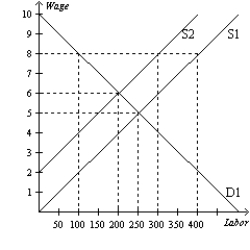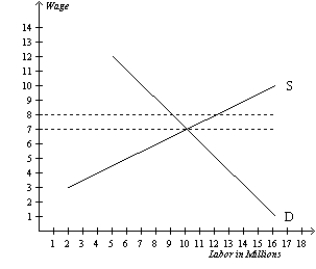A) race.
B) level of education.
C) attitudes toward risk.
D) All of the above are forms of discrimination.
F) All of the above
Correct Answer

verified
Correct Answer
verified
True/False
The signaling theory of education maintains that workers who complete specific levels of education enhance their productivity through education.
B) False
Correct Answer

verified
Correct Answer
verified
Multiple Choice
Evidence suggests that business owners are generally
A) interested in profits only when discrimination is illegal.
B) more interested in discrimination than in making a profit.
C) unable to determine the link between discrimination and profitability.
D) more interested in making a profit than in discriminating against a particular group.
F) C) and D)
Correct Answer

verified
Correct Answer
verified
Short Answer
Cheryl is a professor at a local university. She hired a student from the university to babysit for her children and paid the student a wage higher than the typical wage paid to babysitters in her area to ensure the babysitter's reliability and that attention is paid to her children. What is the name for this above-equilibrium wage?
Correct Answer

verified
Correct Answer
verified
Short Answer
Figure 19-6  -Refer to Figure 19-6. Given demand, D1, and supply, S1, what is the quantity of labor demanded if a minimum wage of $8 per hour is imposed on this market?
-Refer to Figure 19-6. Given demand, D1, and supply, S1, what is the quantity of labor demanded if a minimum wage of $8 per hour is imposed on this market?
Correct Answer

verified
Correct Answer
verified
Multiple Choice
Which of the following variables related to a worker's wage are the most difficult to measure?
A) ability, effort, and chance
B) job characteristics, gender, and race
C) gender, race, and geographic location
D) years of schooling, age, and years of experience
F) B) and D)
Correct Answer

verified
Correct Answer
verified
True/False
A compensating differential is a difference in wages due to higher levels of education or other forms of human capital.
B) False
Correct Answer

verified
Correct Answer
verified
True/False
Sometimes workers earn higher wages through chance.
B) False
Correct Answer

verified
Correct Answer
verified
Multiple Choice
Workers whose skills become obsolete as a result of technological change are often paid a lower wage as a result of
A) natural ability.
B) geographic location of employment.
C) chance.
D) work effort.
F) None of the above
Correct Answer

verified
Correct Answer
verified
Multiple Choice
Which of the following factors does not affect the value of a worker's marginal product?
A) discrimination against a particular group of workers by a firm's customers
B) a worker's level of disposable income
C) a worker's level of human capital
D) compensating wage differentials
F) All of the above
Correct Answer

verified
Correct Answer
verified
Multiple Choice
Over the past several years, the earnings gap between high-skilled and low-skilled workers has
A) (i) only
B) (ii) only
C) (i) and (iii) only
D) (ii) and (iv) only
F) All of the above
Correct Answer

verified
Correct Answer
verified
Multiple Choice
A difference in wages between a highly-educated worker and a less-educated worker
A) may be due to a difference in the amounts of human capital between the workers.
B) may be a signal that the market is indifferent to a worker's level of human capital.
C) is considered unfair by economists.
D) is considered unfair by everyone.
F) C) and D)
Correct Answer

verified
Correct Answer
verified
Multiple Choice
A signaling theory of education suggests that educational attainment
A) is a signal of high marginal productivity.
B) is correlated with natural ability.
C) increases the productivity of low-ability workers.
D) Both a and b are correct.
F) All of the above
Correct Answer

verified
Correct Answer
verified
Multiple Choice
Evidence from a study of the market for baseball players using 1960s data
A) indicated that sports with strong player associations are unlikely to experience wage discrimination.
B) suggested that government regulation had eliminated most evidence of wage discrimination.
C) found some evidence of consumer-driven wage discrimination.
D) found that measurement of marginal productivity was very difficult for baseball players.
F) A) and D)
Correct Answer

verified
Correct Answer
verified
Multiple Choice
The idea of paying workers an efficiency wage is that
A) employers will find it profitable to hire more workers.
B) workers receive wages consistent with their specific compensating differentials.
C) workers and management gain at the expense of the stockholders of the company.
D) workers have the incentive to work harder, thus increasing their marginal productivity.
F) B) and D)
Correct Answer

verified
Correct Answer
verified
Multiple Choice
Which of the following could explain the changing gap in income between unskilled and skilled workers in the United States?
A) International trade has decreased the domestic demand for skilled labor and increased the domestic demand for unskilled labor.
B) Certain technological changes such as the introduction of computers have increased the domestic demand for skilled labor and decreased the domestic demand for unskilled labor.
C) Both a and b are correct.
D) Neither a nor b is correct.
F) A) and D)
Correct Answer

verified
Correct Answer
verified
Multiple Choice
Figure 19-1  -Refer to Figure 19-1. What is the change in employment of having the minimum wage at $8 instead of $7?
-Refer to Figure 19-1. What is the change in employment of having the minimum wage at $8 instead of $7?
A) 2 million jobs are gained
B) no jobs are gained or lost
C) 1 million jobs are lost
D) 3 million jobs are lost
F) A) and C)
Correct Answer

verified
Correct Answer
verified
True/False
Daryn earns a higher salary than his friend Nick because Daryn is willing to work on the loading dock, whereas Nick prefers to work in an air-conditioned office. The difference in salary could illustrate a compensating differential.
B) False
Correct Answer

verified
Correct Answer
verified
True/False
A computer is an example of human capital.
B) False
Correct Answer

verified
Correct Answer
verified
Multiple Choice
Scenario 19-2 Travis, a student at a community college, is considering what he should do for summer employment. Two recruiters show up at his school in search of summer workers. Recruiter A is looking for workers to help a disaster relief agency distribute food aid in Africa. Recruiter B is looking for custodial help to clean motel rooms in a motel located near the entrance to a famous national park. -Refer to Scenario 19-2. Travis is carefully considering the options that each recruiter presents. On the basis of knowledge obtained in his economics class, Travis concludes that
A) if the motel job requires some night shift work, wages will be lower than otherwise.
B) the job that is more fun will have a higher wage.
C) if the motel job doesn't require any special skills, the wage offer will be lower than otherwise.
D) All of the above are correct.
F) A) and D)
Correct Answer

verified
Correct Answer
verified
Showing 461 - 480 of 490
Related Exams